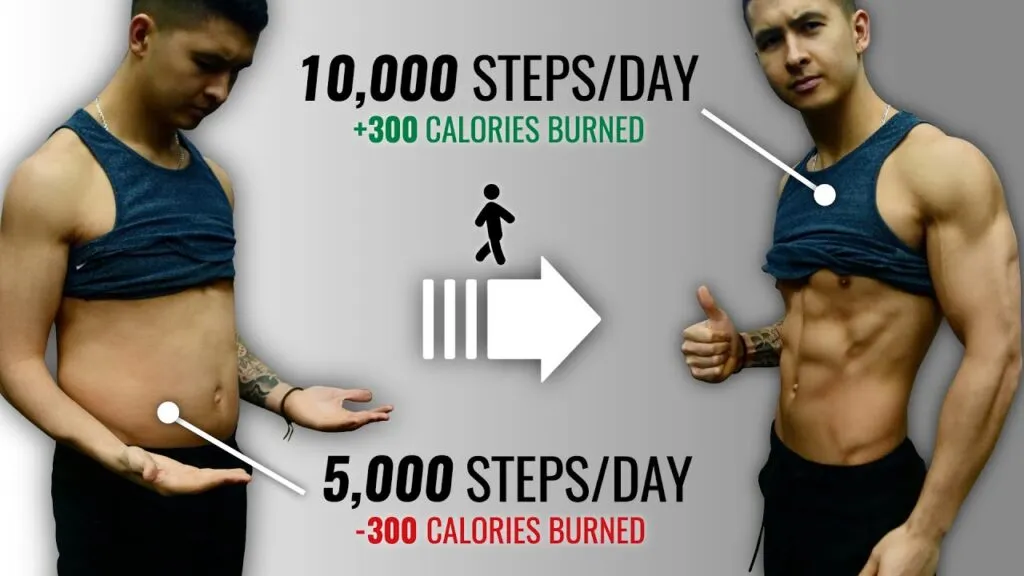Curious about whether walking 10,000 steps a day can truly lead to weight loss? You’re not alone. Many people have wondered the same thing. In this article, we’ll explore the effectiveness of this popular fitness trend and whether it can really help shed those extra pounds. So, grab your walking shoes and let’s find out if taking those 10,000 steps each day is the key to reaching your weight loss goals.

Benefits of Walking
Physical Health Benefits
Walking provides numerous physical health benefits. It is a low-impact exercise that helps improve cardiovascular fitness, strengthen muscles and bones, and enhance overall physical stamina. Regular walking can lower blood pressure, reduce the risk of heart disease and stroke, and improve lung function. It also promotes better digestion, boosts the immune system, and increases energy levels. Walking is a great way to stay active and maintain a healthy body.
Mental Health Benefits
Apart from physical advantages, walking also has several mental health benefits. Taking a walk can help reduce stress, anxiety, and depression. It releases endorphins, which are natural mood-boosting hormones, and stimulates the production of serotonin, which promotes feelings of well-being. Walking outdoors in nature can have a calming and rejuvenating effect on the mind. It can improve cognitive function, enhance creativity, and provide a sense of clarity. Engaging in regular walks can contribute to better mental health and overall happiness.
Weight Loss Benefits
For those aiming to shed some extra pounds, walking can be an effective tool. Walking regularly at a brisk pace can increase calorie expenditure, leading to weight loss over time. Walking helps create a caloric deficit, where the number of calories burned exceeds the number consumed. As a low-impact exercise, walking can be suitable for individuals of all fitness levels, making it a sustainable weight loss strategy. Additionally, the act of walking can help curb cravings and reduce snacking, aiding in weight management.
Understanding the 10,000 Steps Goal
Origins of the 10,000 Steps Goal
The concept of walking 10,000 steps a day originated in Japan in the mid-1960s. The idea was introduced by a company named Yamasa Clock, which manufactured pedometers. The pedometer was marketed as “manpo-kei,” which translates to “10,000 steps meter.” The number was chosen based on the Japanese character for “10,000” resembling a person walking. This catchy marketing campaign popularized the idea worldwide, leading to the adoption of the 10,000 steps goal as a measure of physical activity.
The Science Behind the Goal
While the 10,000 steps goal may seem arbitrary, research supports its potential benefits. Studies have shown that individuals who consistently walk 10,000 steps a day experience improvements in cardiovascular health, weight management, and overall fitness. Meeting this goal increases physical activity levels and can contribute to meeting the recommended daily activity guidelines. However, it is essential to note that the intensity and duration of walking also play significant roles in achieving desirable outcomes.
Suitability for Different Individuals
The 10,000 steps goal may not be suitable for everyone. Factors such as age, fitness level, and existing health conditions need to be considered when determining an appropriate step target. For individuals who are new to exercise or have mobility limitations, starting with a lower step count and gradually increasing it can be more realistic and achievable. It is important to listen to your body, consult a healthcare professional if needed, and personalize your walking routine to fit your unique circumstances and goals.
Factors Affecting Weight Loss
Caloric Deficit
Creating a caloric deficit is crucial for weight loss. Walking can help in achieving this deficit by increasing energy expenditure. However, it is important to keep in mind that the number of calories burned during a walk depends on factors such as body weight, pace, and duration. Combining walking with other forms of exercise and maintaining a balanced diet are also essential for creating a sustainable caloric deficit.
Dietary Habits
Weight loss is not solely dependent on physical activity; dietary habits play a significant role as well. While walking can contribute to calorie burning, it is important to maintain a balanced and nutritious diet to support weight loss efforts. Incorporating whole foods, reducing processed foods, and practicing portion control can enhance the effectiveness of walking for weight loss.
Intensity and Duration of Walking
To maximize weight loss benefits, the intensity and duration of walking should be taken into account. A brisk pace can increase calorie expenditure and improve cardiovascular fitness. Gradually increasing the duration of walks can also contribute to greater weight loss over time. However, it is crucial to find a pace and duration that are sustainable and enjoyable for you to maintain consistency.
Overall Physical Activity Levels
While walking can be an excellent form of exercise, it is important to engage in a variety of physical activities for overall health and weight loss. Incorporating strength training exercises can help build lean muscle mass, which can boost metabolism and aid in weight loss. Additionally, including other cardiovascular activities and high-intensity interval training (HIIT) can provide a well-rounded approach to weight management.
Real-Life Experiences
Personal Testimonials
Many individuals have reported successful weight loss through walking. Personal testimonials often highlight the importance of consistency, finding joy in the activity, and making walking a daily habit. By incorporating walking into their routines, individuals have achieved significant weight loss and experienced other positive effects on their overall health and well-being.
Research Studies
Research studies have also explored the relationship between walking and weight loss. Several studies have found that walking can lead to weight loss when combined with appropriate lifestyle modifications. These studies emphasize the importance of personalized approaches, considering individual factors such as age, fitness level, and health conditions. The results suggest that walking can be a valuable component of a weight loss strategy.
Challenges Faced
While walking for weight loss can be effective, it is not without its challenges. Some individuals may struggle with finding motivation, especially when starting a new exercise routine. Weather conditions, time constraints, and personal commitments can also pose obstacles to consistent walking. Overcoming these challenges often requires planning, setting achievable goals, and finding support through friends, family, or fitness communities.

Tips for Effective Weight Loss
Combining Walking with Other Exercises
To maximize weight loss results, consider combining walking with other exercises. Engaging in strength training exercises, such as weightlifting or bodyweight exercises, can help build muscle and increase metabolism. Incorporating activities like swimming, cycling, or dancing can provide variety and enhance cardiovascular fitness.
Balanced and Nutritious Diet
A balanced and nutritious diet is crucial for successful weight loss. Focus on consuming whole foods, such as fruits, vegetables, lean proteins, and whole grains. Avoid or minimize processed foods, sugary drinks, and excessive calorie intake. Balancing calorie intake with calorie expenditure through walking can create a sustainable and effective weight loss approach.
Consistency and Persistence
Consistency and persistence are key to achieving weight loss through walking. Make walking a daily habit and aim to meet your personalized step target consistently. Even on days when motivation is low, prioritize getting out for a walk. Celebrate small victories, and remember that long-term success often comes from sustained effort and dedication.
Monitoring and Tracking Progress
Monitoring and tracking your progress can provide motivation and help identify patterns or adjustments needed. Utilize pedometers, fitness trackers, or smartphone apps to record your steps, distances, and other relevant data. Seeing improvements and progress can reinforce the positive impact walking has on your weight loss journey.
Potential Pitfalls and Misconceptions
Believing Steps Alone Guarantee Weight Loss
While walking is beneficial for weight loss, it is important to recognize that steps alone do not guarantee weight loss. Achieving weight loss requires creating a caloric deficit through a combination of dietary modifications, increased physical activity, and overall lifestyle changes. Simply reaching 10,000 steps without considering other factors may not lead to significant weight loss.
Focusing Solely on Steps without Considering Intensity
While reaching the 10,000 steps goal is a good benchmark for overall physical activity, the intensity of those steps is also critical for weight loss. Walking at a brisk pace or incorporating periods of higher intensity can increase calorie burn and cardiovascular fitness. Therefore, focusing on the intensity of walking, in addition to step count, can lead to more effective weight loss results.
Neglecting Other Aspects of a Healthy Lifestyle
Weight loss is a holistic process that extends beyond walking alone. Neglecting other aspects of a healthy lifestyle, such as adequate sleep, managing stress, and maintaining hydration, can hinder weight loss progress. Make sure to prioritize overall well-being and embrace a comprehensive approach to healthy living.
Overestimating Caloric Burn
While walking is an effective way to burn calories, it is important to avoid overestimating the number of calories burned during a walk. Pedometers, fitness trackers, and smartphone apps may provide estimations, but they are not always precise. These tools can serve as rough guides, but it is essential to focus on the consistency and overall impact of walking rather than solely relying on calorie calculations.

Expert Opinions
Health Professionals’ Perspectives
Health professionals often encourage walking for weight loss due to its accessibility and numerous health benefits. They emphasize the importance of overall physical activity, incorporating strength training, and maintaining a balanced diet. Consulting with a healthcare professional can provide personalized guidance and support based on individual needs.
Fitness Experts’ Recommendations
Fitness experts promote walking as an effective exercise for weight loss. They suggest incorporating different walking techniques, such as interval training or incline walking, to increase intensity. They also recommend finding walking routes or environments that are enjoyable and stimulating. Fitness experts often emphasize the long-term commitment to a walking routine for sustainable weight loss results.
Weight Loss Specialists’ Insights
Weight loss specialists recognize the potential of walking as part of a comprehensive weight loss strategy. They stress the importance of individual customization, considering factors such as age, health conditions, and fitness levels. Weight loss specialists often advocate for combining walking with other exercises and implementing dietary modifications for optimal results.
Alternative Approaches to Weight Loss
Combining Walking with Other Cardiovascular Activities
To enhance weight loss efforts, consider incorporating other cardiovascular activities alongside walking. Engaging in activities such as swimming, cycling, or dancing can increase overall calorie burn, improve cardiovascular fitness, and provide variety to your exercise routine.
Strength Training for Better Results
Including strength training exercises in your routine can contribute to better weight loss results. Building muscle mass through exercises like weightlifting or bodyweight workouts can increase metabolism and promote fat loss. Combining strength training with walking can provide a well-rounded approach to weight management.
High-Intensity Interval Training (HIIT)
High-Intensity Interval Training (HIIT) involves alternating between short bursts of intense exercise and brief recovery periods. Incorporating HIIT workouts, such as sprint intervals or stair climbing, can increase the calorie burn during and after the exercise session, leading to more efficient weight loss.
Incorporating Mindfulness and Stress Reduction Techniques
Stress and emotional factors can impact weight loss. Incorporating mindfulness techniques, such as meditation or deep breathing exercises, can help manage stress levels. Reducing stress can prevent emotional eating and support weight loss efforts. Taking time for self-care and practicing stress reduction techniques in conjunction with walking can provide a holistic approach to weight loss.

Conclusion
Walking is a beneficial activity that offers numerous physical and mental health benefits. While walking 10,000 steps a day can contribute to weight loss, it is important to customize the goal to fit individual circumstances. Personalization, along with incorporating other exercises, maintaining a balanced diet, and considering overall lifestyle factors, is key to achieving successful weight loss through walking. Remember, being consistent, maintaining a positive mindset, and enjoying the process are essential for long-term weight management. So lace up your shoes, step outside, and embark on your journey to better health and well-being through the power of walking.






